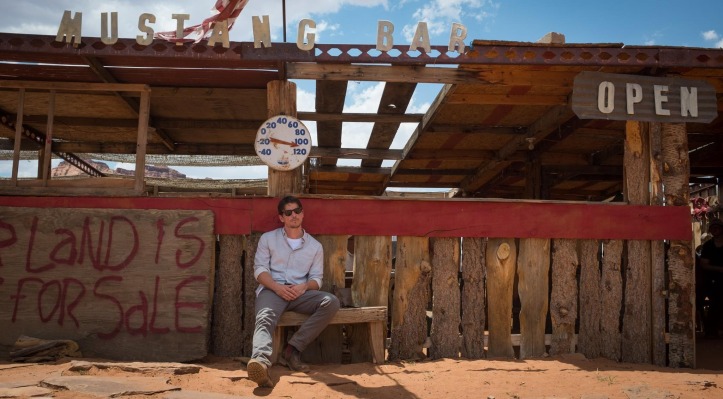
The Valley of the Gods is a sandstone valley in the American desert. It is an iconic landscape, best known to most people from Western films, many filmed in the nearby and similar Monument Vallery. The fascinaton goes back even to the 19th-century when Europeans first encountered the mysterious canyons and buttes (rock formations) in the desert, an earthly place unlike anything they’d seen before. Here nature has carved the red sandstone into great temples and edifices like silhouettes of cities. It is a fitting backdrop for elemental stories about heroes and villains, the melodramatic essence of the Western.
But this landscape did not belong to the interlopers, it was always inhabited by native Americans, particular the Navajo, who approached the environment with their own interpretations, their own mythologies, their own gods and their own demons. The territory is, moreover, still under threat from potential development. At the core of the film is the Navajo belief that the rock formations are places of power where spirits reside. These monoliths are Navajo warriors frozen in stone, who can be called upon to protect the land and its true inhabitants.
Lech Majewski’s film Valley of the Gods attempts to weave various different threads together in the narrative that resembles not so much a line or a story – perhaps we can see it as a blanket where each coloured thread intersects with another, creating an image and a form and then moving on.
One thread has Tauros (John Malkovich), a rich man who seeks to own this world and control it, but Is obsessed with his own death and desire for immortality. (Interestingly, this is the second film I’ve seen recently which posits the notion of a super-rich capitalist obsessed with his own immortality and ready to manipulate large numbers of other people in order to facilitate this. Second film being Under the Silver Lake by David Robert Mitchell. Obviously it’s a Zeitgeist theme) Tauros is a Bluebeard, lifted from the European folk tale where women are used and expended by rich and powerful man; but here we see, not only women but artists, intellectuals thinkers of all kinds, are lured in and kept by him.
The writer, played by Josh Hartnett, writes this world into existence but also – without his knowledge or understanding – has the power to destroy it, or simply to write himself into his own bliss. More pointedly, Majewski depicts how Navajo life is being degraded and doesn’t shy away from showing both the ennui of reservation life and the depredations that European colonialism has wreaked upon the people. He explores the way in which Monument Valley has deep but often very different and contradictory meanings to Europeans (like himself), Americans and the Navajo.
Make no mistake, this is a European artist’s film and despite the Hollywood stars and the location it is about as far away from a Hollywood film as a film can get. Majewski, who is a painter and a theatre maker as well as a filmmaker, pays special attention to particular invocations of landscape with very strong use of color, and elicits very different types of performances from his actors. Moving frequently between realism and stylisation in Majewski’s painterly vision, the narrative’s elliptical and mythic threads weave in and out of realism and the only tangible thing is the land which itself is sentient. People are changeable, inhabiting multiple identities which at times they acknowledge.
At different moments the film recalled Tarkovsky (particularly the senitent landscapes of Stalker) but also the philosophical questioning of being amid nothingness, and questioning one’s multiple senses of identity and singular sense of self. Antonioni’s desert visions of Zabriskie Point and The Passenger are present here, as is the mythic stylisation of Parajanov, particularly in the theatrical scenes with the Navajo. Watching Valley of the Gods I understood that it takes a certain kind of confidence and strength to make a picture of this kind, a picture which is not easy to make nor to watch. Long after you’ve seen it, the film will stay with you. I think it will stay with me for a long time.
seen at Camerimage 2019
You must be logged in to post a comment.